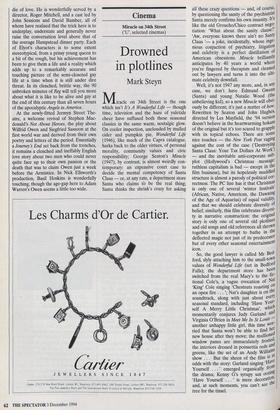Cinema
Drowned in plotlines
Mark Steyn
Miracle on 34th Street is the one which isn't It's A Wonderful Life — though time, television and the haze of yuletide cheer have suffused both these seasonal classics in the same warm, nostalgic glow. On cooler inspection, unclouded by mulled cider and pumpkin pie, Wonderful Life (1946), like much of the Capra catalogue, harks back to the older virtues, of personal morality, community values and civic responsibility; George Seaton's Miracle (1947), by contrast, is almost weirdly con- temporary: an expensive court case to decide the mental competency of Santa Claus — or, at any rate, a department store Santa who claims tb be the real thing; Santa thinks the shrink's crazy for asking all these crazy questions — and, of course, by questioning the sanity of the psychiatrist Santa merely confirms his own insanity. It's like the old Groucho/Chico contract nego- tiation: 'What about the sanity clause? `Aw, everyone knows there ain't no SantY Claus '— a joke, incidentally, whose inge- nious conjuction of psychiatry, litigation and celebrity is a perfect distillation of American obsessions. Miracle brilliantly anticipates by 40 years a world where you're fingered by therapists and cleaned out by lawyers and turns it into the ulti- mate celebrity downfall.
Well, it's not 1947 any more, and, in anY case, we don't have Edmund Gwen" (Santa) and young Natalie Wood (the unbelieving kid), so a new Miracle will obvi- ously be different; it's just a matter of how. Rewritten by Seaton and John Hughes, directed by Les Mayfield, the '94 version doesn't believe in the heartwarming hokturt of the original but it's too scared to grapple with its topical echoes. There are some nice touches — the New York Post raging against the cost of the case (Destroying Santa Claus: Your Tax Dollars At Work') — and the inevitable anti-corporate sub- plot (Hollywood's Christmas message: ruthless capitalism is bad — except in the film business), but its hopelessly muddled structure is almost a parody of political cor- rectness. The PC line has it that Christmas, is only one of several 'winter festivals (African, Native, American, the Dawning of the Age of Aquarius) of equal validitY, and that we should celebrate diversity of belief; similarly, this film celebrates diversi- ty in narrative construction: the original story is only one of several old plotlines and old songs and old references all thrown together in an attempt to bathe in the deflected magic not just of its predecessor but of every other seasonal entertainment icon.
So, the good lawyer is called Mr Bed- ford, slyly attaching him to the small-town values of Wonderful Life (set in Bedford Falls); the department store has been switched from the real Macy's to the fic- tional Cole's, a vague evocation of Nat 'King' Cole singing 'Chestnuts roasting 011 an open fire . '; Nat's daughter is on the soundtrack, along with just about even' seasonal standard, including 'Have Yoia- self A Merry Little Christmas', which momentarily conjures Judy Garland and Virginia O'Brien in Meet Me In St Louis another unhappy little girl, this time wor- ried that Santa won't be able to find ber, new house after they move; the mullion window panes are immaculately frost the interiors dressed in poinsettia reds an° greens, like the set of an Andy Williains show . . But the sheen of the film is odds with the story: Garland singing 'H- Yourself . . . ' emerged organically fr°._ the drama; Kenny G's syrupy sax oa,ing 'Have Yourself . . . ' is mere decoration, and, at such moments, you can't see the tree for the tinsel. Yet at its heart are two exquisite perfor- mances. Not Mara Wilson, who's no Natal- ie Wood and gets sidelined by the Cumbersome storyline, and certainly not Richard Attenborough's Santa. Instead, What life the film possesses resides with Elizabeth Perkins, as the store PR officer, and Dylan McDermott, as her part-time boyfriend and Santa's lawyer. You won't see anything crueller this Christmas than Miss Perkins's rejection of McDermott's proposal: 'Have I ever given you a sign that I wanted to marry you?' 'I put my faith in You.' If that's true, you're a fool.' The story is about faith, but the film- m. akers have no faith in the story — which is why they drown it in Kenny G. Com- pared to Attenborough, Edmund Gwenn never looked that much like Santa; he could easily have been just a cranky old fruitcake: the film demands faith from us. Benign, bewhiskered, avuncular Attenbor- ough is a Hollywood Santa: he looks and talks right, so who needs faith? It's not enough. With the same half-heartedness with Which the Prince of Wales defends the Australian monarchy, Santa can come up With nothing more persuasive for the little girl than Tin a symbol of the human ability to suppress the selfish tendencies that rule the major part of our lives.' Is such a Santa worth believing in?











































































 Previous page
Previous page